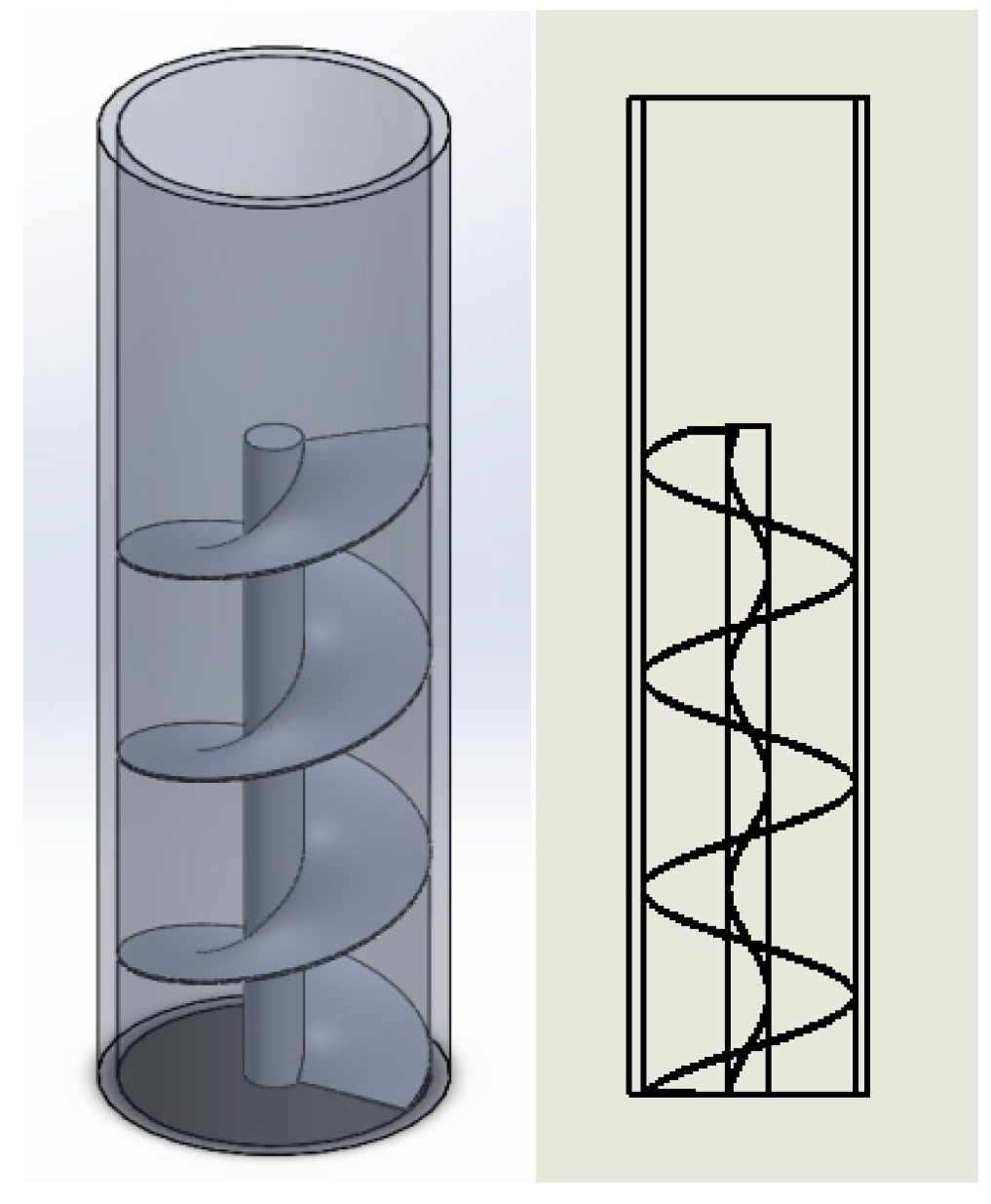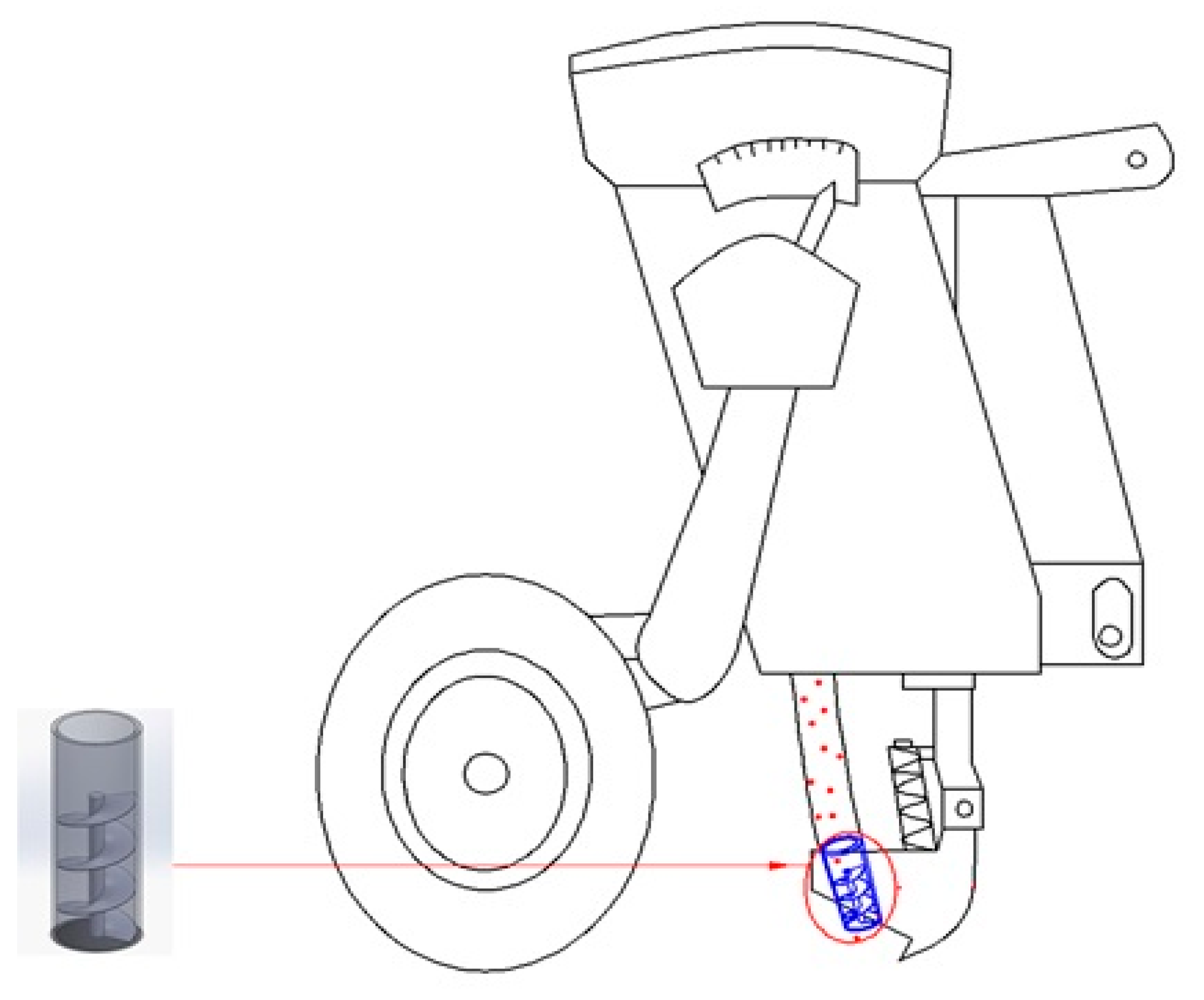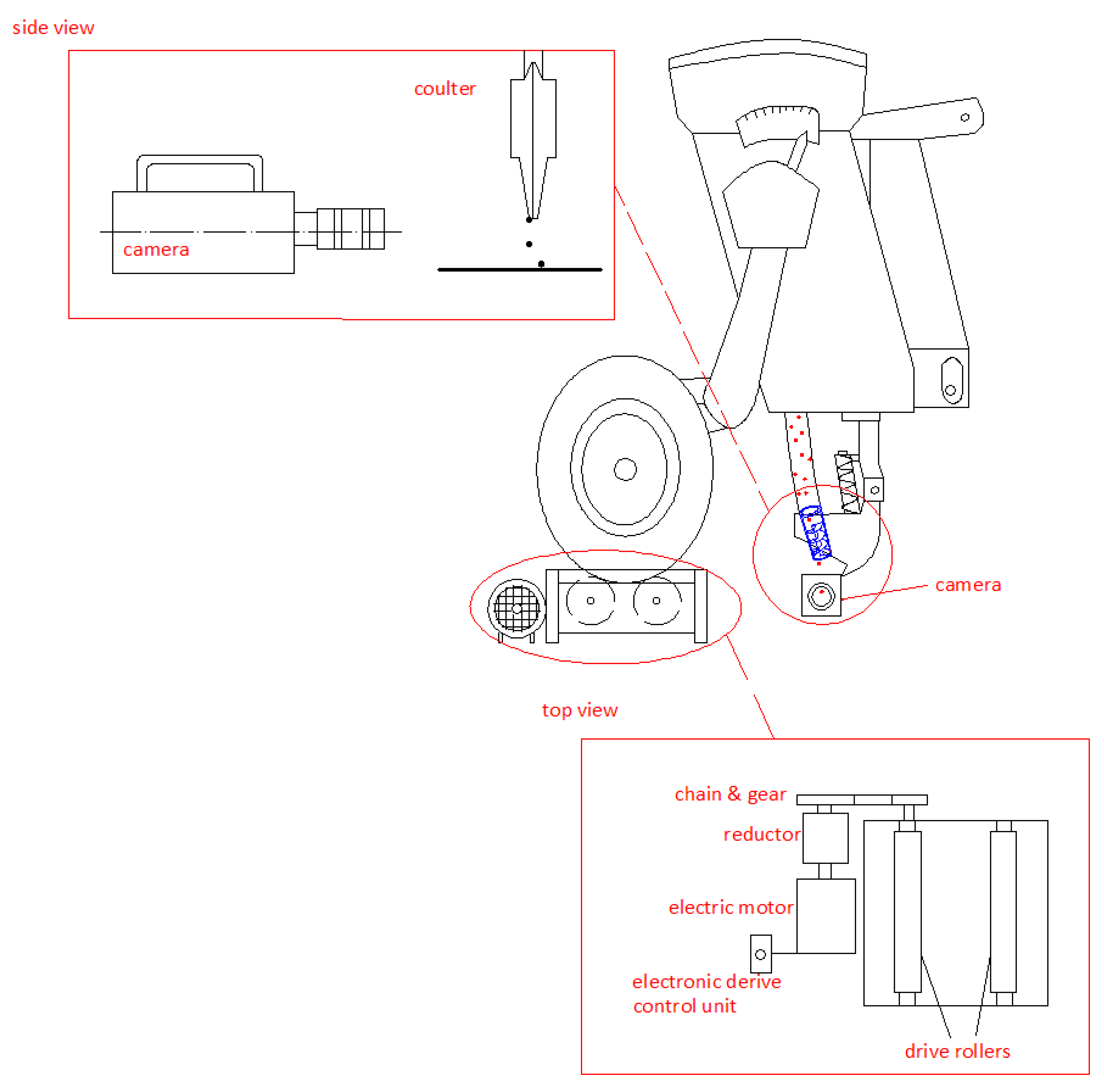1. Introduction
The sowing uniformity of a seed drill is a critical factor affecting the emergence, plant development and yield. In addition to factors that increase crop yield, such as tillage, fertilization, and plant protection, an increase in crop yield can be achieved by providing a uniform seed distribution and optimum growing area. After the sowing process, the distribution of seeds in the soil is expressed as a horizontal and vertical distribution. Metering mechanisms of seed drills are primarily effective in ensuring a uniform seed distribution in a horizontal plane. But it should be taken into consideration that the problems that will occur until the seeds, which are activated (delivered) by the metering mechanism, are placed in the soil have an effect on seed distribution uniformity. The seed distribution uniformity in the horizontal plane is influenced by the distance between the successive seeds as well as the deviation of seeds from the furrow axis. The distance between the row and seed spacings in the row determines the plant growing area of seeds. The deviations from the theoretical spacing constitute the seed distribution uniformity in the horizontal plane. Improving the seed distribution uniformity of a seed drill will allow a seed to have its optimum growing area that will avoid the competition for nutrients with its neighboring plants, which in turn increases yield [
1,
2,
3].
The improvement of the seed distribution uniformity in the sowing process contributes to the proximity of the plant growing area per seed relative to each other and thus to the increase of yield [
1]. In addition, the reduction of weeds is achieved by reducing the gaps between neighboring seeds. Generally, the seed distribution uniformity in the horizontal plane and the distribution uniformity of the plant growing areas are not very good in conventional seed drills. According to Müller and Köller, mechanical seed drills distribute seeds exponentially. The rate of seeds sown at the desired spacing over the row was very low for mechanical seed drills. The coefficient of variation of the seed spacing in wheat sowing with mechanical seed drills was between 100% and 110%. The deviation in the seed spacing was greater than the mean seed spacing. In the wheat sowing at the sowing rate of 300 kg/ha, the mean seed spacing was 20 mm, while the standard deviation of the seed spacing was 22 mm. The authors claimed that one of the main reasons for this non-uniformity was the irregular flow of seeds in the seed tube. The other factors affecting the seed distribution uniformity may be the seed metering device, furrow opener, and furrow conditions. Plain (hollow) seed tubes used in conventional seed drills lead to the unsteady flowing of seeds through the tube, resulting in irregular seed spacing along the row [
4,
5].
In order to achieve a better seed distribution, the rate of seeds sown at the desired spacing should be increased. Traditional mechanical seed drills drop the seeds in furrow lines in a continuous stream. One of the main reasons for the poor seed distribution in the mechanical seed drills is the irregular movement of the seeds in the seed tube. Delivered (activated) seeds by the metering units and left in the seed tube move in the seed tube completely by chance, under the effect of gravity. Since the number of striking of seeds to the wall of the seed tube and the trajectory of seeds is different, the falling time is also different, and therefore the seed flow is not uniform. As a result, when the seeds leave the seed tube and are placed in the soil, their distribution on the row is irregular (or non-uniform). No matter how good a metering unit is used, the seed flow is disrupted due to the movement of seeds in the seed tube [
5,
6].
In previous years, extensive efforts have been made by manufacturers to improve volumetric metering devices. However, the problem is that a high uniformity of metering is mixed up in the seed tube, leading again to a random distribution of seed spacing in the field. In order to optimize the performance of a seeder, the structure of the seed-metering device, seed tube, and furrow openers should be optimized in terms of seed movement, trajectory, and deposition [
7]. To improve the seed distribution uniformity, Chen and Zhong designed a belt-type seed delivery system for the air-suction metering device. The results of the research showed that the acceptable rate of seed spacing was 98.50% when the height of the outlet (dropping) point of seeds was 100 mm. Through the optimal design of the seed tube, the seeding quality (seed distribution uniformity) was improved. Therefore, the design of the seed tube and the process of seed dropping was found to be the main factor affecting the seeding quality of seeders [
8].
Limited research has been carried out to evaluate seed flow uniformity in the seed tubes or seed tube outlet. Endrerud investigated the kinetic energy of seeds sliding and falling down in a seed tube. The author suggested that the seed tube leading to the bend should be inclined at 60° to the horizontal plane [
9]. Kumar and Raheman developed an embedded system to detect seed flow in the seed tube and blockages in a seed drill [
6]. Müller and Köller used a cascade of V-shaped ducts in the furrow opener to increase the uniformity of seed flow after the seed tube. The seeds sliding in a furrow opener with a V-shaped duct system improved seed spacing uniformity in the row. The authors point out that even for drills utilizing a high-quality seed metering device, the non-optimal layout of tubes can aggravate the seed distribution accuracy in the seed rows [
5]. Liu and Yang applied reverse engineering design to design a seed tube of a drill. The authors suggested that reverse engineering for designing the seed tube shortened the design time and reduced design cost compared to theoretical design and experimental study. The built 3D geometric model provides a certain reference for the optimization of seed tubes to improve uniformity of seed flow [
7]. Wang et al. designed a pneumatic wheat-shooting device, aiming to improve the acceleration performance of seeds in seed tubes. The pneumatic wheat-shooting device had a faster and more stable airflow field after the optimization. Results of the field test showed that the optimized pneumatic wheat-shooting device had about 68% higher seeding depth than the initial device [
10].
Yazgi et al. evaluated seed trajectories in different seed tubes. They found that the seed release point of the precision metering mechanism to the seed tube is an effective factor in seed distribution uniformity, because the release point of seeds from seed metering mechanisms affects the bouncing of the seeds in the seed tube [
11].
Kocher et al. determined the effects of seed tube condition (new or worn) on seed distribution uniformity of the seeders. Corn seeds with round and flat shapes were tested to determine the effect of seed shape on seed flow uniformity in the seed tube. Results showed that seed spacing uniformity was better with the new seed tubes than with the worn seed tubes for all seeders tested in the laboratory with the University of Nebraska Planter Test Stand. Seed spacing uniformity also showed that the round seed used in this experiment had better seed spacing uniformity than the flat seed within the same seed tube condition (new or worn). The authors also suggested that more research on seed tubes is needed to improve seed spacing uniformity [
12].
In order to solve the problem of poor uniformity in traditional seed drills, a new helicoidal seed tube (as an attachment to conventional seed tube exit) was developed in this research so that the irregular seed flow in the seed tube can be made more regular just before the seeds fall to the furrow (soil). The regulation of the flow of the seeds by moving on the spiral and reducing the velocity and kinetic energy of falling seeds (by the effect of friction) is aimed at the development of the new helicoidal seed tube. Thus, the preventing displacement of seeds by bouncing and rolling in the furrow and as a result, providing more uniform seed distribution in the row are targeted.
3. Results and Discussion
The velocity of falling seeds and the times between successive seeds as determined in laboratory tests using the high-speed camera are presented in
Table 3 and
Table 4.
The effects of the helix height and pitch size on the velocity of falling seeds were not statistically significant. As the helix height increased, the standard deviation and coefficient of variation of the velocity of falling seeds decreased (
Table 5). Increasing the helix height improved seed flow uniformity. However, some blockage in helicoidal section of seed tube were observed when the helix was higher than 200 mm. Therefore, the height of helix was limited to 200 mm.
The effects of helix height and pitch size of helicoidal seed tube on the time between successive seeds were not statistically significant. In terms of standard deviation and coefficients of variation, the height of the helicoidal seed tube was the more effective factor than the pitch size. The lowest standard deviation and coefficient of variation of time between successive seeds were obtained at 200 mm helix height (
Table 6).
According to
Table 3,
Table 4,
Table 5 and
Table 6, the lowest standard deviation and the coefficient of variation of the time between successive seeds were obtained when the helicoidal seed tube with a helix height of 200 mm and pitch size of 36 mm was used. For this reason, the helicoidal seed tube with a length of 200 mm and pitch size of 36 mm was subjected to laboratory and field tests to compare with conventional seed tubes.
Mean, standard deviation and coefficient of variation of seed spacings obtained in the laboratory tests are presented in
Table 7 to compare seed tubes. Statistical analysis (
t-test) was performed to compare the mean seed spacings of helicoidal and conventional seed tubes for each seed. According to the result of the statistical test, the effect of seed tube type on seed spacing was significant. While the mean seed spacing was 2.99 cm and 2.83 cm for conventional seed tubes, this value has decreased to 1.96 cm and 2.02 cm for the helicoidal seed tube for wheat and barley seed, respectively. The laboratory test showed that using the helicoidal seed tube decreased the coefficient of variation of the seed spacing from 168.13% and 148.76% to 79.02% and 75.24% for wheat and barley seeds, respectively.
The effect of seed tube type on the velocity of falling seeds was statistically significant for both seeds, as shown in
Table 8. The mean velocity of falling wheat seeds in the conventional seed tube was 2.96 m/s, which was observed to decrease at a velocity of 0.62 m/s in the helicoidal seed tube. Similarly, the standard deviation and coefficient of variation of the velocity of falling wheat seeds were 0.77 m/s and 26.17% for conventional seed tubes, it decreased to 0.05 m/s and 8.06% for helicoidal seed tubes, respectively. Similar results were also obtained in the experiments with barley seeds.
Lei et al. found the phenomenon of collision and bounce between seeds and tube wall and this changed seed motion trajectory with the length of the seed tube, influencing the uniformity of seed-dropping time. The author suggested that the uniformity of seed flow in the seed tube could be improved by reducing the number of collisions in the seed tube, thus, the variation in seed velocity [
17]. The helicoidal seed tube used in our experiments regulated seed flow, reduced the number of collisions in the seed tube, and the variation in seed velocity, and thus, increased seed distribution uniformity.
The velocity of the fall of a seed is a contributing factor to the bouncing and rolling of the seeds in the furrow [
7]. Therefore, the falling velocity of the seed should be minimum in order to lessen bouncing and rolling to avoid seed displacement out of the furrow. In addition, the coefficient of variation of the time between successive seeds is an important indicator of seed distribution uniformity in the furrow. Seed spacings will be formed by multiplying the time between successive seeds by the forward speed of the seed drill. Therefore, a lower coefficient of variation of time between successive seeds is required for a better seed distribution uniformity.
Our results support reports from Müller and Köller, who found the positive effect of V-shaped ducts placed in the furrow opener on the uniformity of seed flow. The friction of the falling seeds while sliding on ducts decreased kinetic energy of the seeds and therefore prevented the bouncing or rolling in the furrow [
4,
5]. A similar effect was observed during the sliding of seeds on the screw of the helix in this study.
According to the results of the laboratory trials, the seed flow with the helicoidal seed tube has become more regular than with the conventional seed tube. Thus, the seed’s distribution accuracy has been improved. The helicoidal seed tube also reduced the mean velocity of falling seeds, allowing the seeds to fall to the furrow at lower speeds.
The mean, standard deviation, and coefficient of variation of seed spacings obtained in the field tests are presented in
Table 9. The effect of seed tube type on seed spacing was statistically significant. While the mean spacing of wheat seeds was 3.7 cm for the conventional seed tube, this value has decreased to 2.5 cm for the helicoidal seed tube. While the standard deviation and coefficient of variation of spacings between wheat seeds were 4.4 cm and 118.4% for conventional seed tubes, it decreased to 1.9 cm and 77.2% for helicoidal seed tubes, respectively. The positive effect of the helicoidal seed tube on the seed distribution uniformity in the field was also observed in the experiments with barley seeds.
The lateral seed scatter (the deviation from the row center of the seeds) was lower when the helicoidal seed tube was used. The lower the velocity of falling seeds to the furrow, the reduced the lateral seed scattering.
The effect of conventional and helicoidal seed tubes on the plant growing area is presented in
Table 10. The effect of seed tube type on plant growing area was statistically significant. The mean, standard deviation, and coefficient of variation of plant growing area decreased when the helicoidal seed tube was used.
The helicoidal seed tube provided a more equal growing area for each plant (
Figure 5). Thus, competition between plants will be reduced and they will be provided to benefit equally from factors such as soil moisture, plant nutrients, and sunlight.
4. Conclusions
A new type of seed tube called a helicoidal seed tube was designed. The optimum value of helix height and pitch size of the seed tube was determined as 200 mm and 36 mm, respectively, in the laboratory. Then, the performance of the helicoidal seed tube in terms of seed distribution uniformity was compared with the conventional seed tube for laboratory and field conditions.
The seed drill was operated at the seeding rate of 200 kg/ha and forward speed of 1 m/s both at the laboratory and field trials. The use of a helicoidal seed tube reduced the mean, standard deviation, coefficient of variation of seed spacings and velocity of falling seeds as compared to the conventional seed tube.
The process of seed ejection from the seed tube is one of the main factors affecting the seeding performance of seed drills. The helicoidal seed tube reduced the number of collisions in the seed tube and the variation in seed velocity. Allowed the seeds to fall to the furrow with lower velocity and kinetic energy. The low kinetic energy of the seeds reduced their displacement by bouncing or rolling.
As a result, the helicoidal seed tube provided a more equal distribution of the seed and the growing area per plant in the field. This will contribute to reducing competition between plants.












